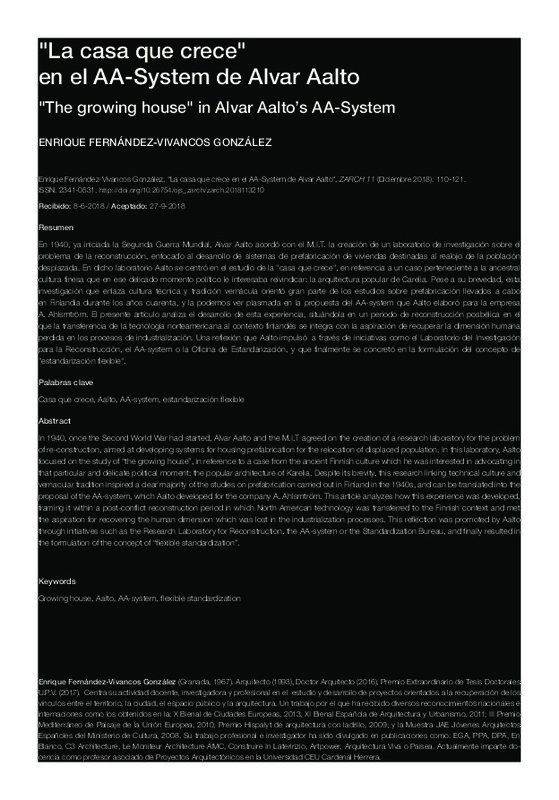|
Resumen:
|
[EN] In 1940, once the Second World War had started, Alvar Aalto and the M.I.T agreed on the creation of a research laboratory for the problem of re-construction, aimed at developing systems for housing prefabrication for ...[+]
[EN] In 1940, once the Second World War had started, Alvar Aalto and the M.I.T agreed on the creation of a research laboratory for the problem of re-construction, aimed at developing systems for housing prefabrication for the relocation of displaced population. In this laboratory, Aalto focused on the study of ¿the growing house¿, in reference to a case from the ancient Finnish culture which he was interested in advocating in that particular and delicate political moment: the popular architecture of Karelia. Despite its brevity, this research linking technical culture and vernacular tradition inspired a clear majority of the studies on prefabrication carried out in Finland in the 1940s, and can be translated into the proposal of the AA-system, which Aalto developed for the company A. Ahlsmtröm. This article analyzes how this experience was developed, framing it within a post-conflict reconstruction period in which North American technology was transferred to the Finnish context and met the aspiration for recovering the human dimension which was lost in the industrialization processes. This reflection was promoted by Aalto through initiatives such as the Research Laboratory for Reconstruction, the AA-system or the Standardization Bureau, and finally resulted in the formulation of the concept of ¿flexible standardization¿.
[-]
[ES] En 1940, ya iniciada la Segunda Guerra Mundial, Alvar Aalto acordó con el M.I.T. la creación de un laboratorio de investigación sobre el problema de la reconstrucción, enfocado al desarrollo de sistemas de prefabricación ...[+]
[ES] En 1940, ya iniciada la Segunda Guerra Mundial, Alvar Aalto acordó con el M.I.T. la creación de un laboratorio de investigación sobre el problema de la reconstrucción, enfocado al desarrollo de sistemas de prefabricación de viviendas destinadas al realojo de la población desplazada. En dicho laboratorio Aalto se centró en el estudio de la "casa que crece", en referencia a un caso perteneciente a la ancestral cultura finesa que en ese delicado momento político le interesaba reivindicar: la arquitectura popular de Carelia. Pese a su brevedad, esta investigación que enlaza cultura técnica y tradición vernácula orientó gran parte de los estudios sobre prefabricación llevados a cabo en Finlandia durante los años cuarenta, y la podemos ver plasmada en la propuesta del AA-system que Aalto elaboró para la empresa A. Ahlsmtröm. El presente artículo analiza el desarrollo de esta experiencia, situándola en un periodo de reconstrucción posbélica en el que la transferencia de la tecnología norteamericana al contexto finlandés se integra con la aspiración de recuperar la dimensión humana perdida en los procesos de industrialización. Una reflexión que Aalto impulsó a través de iniciativas como el Laboratorio del Investigación para la Reconstrucción, el AA-system o la Oficina de Estandarización, y que finalmente se concretó en la formulación del concepto de "estandarización flexible".
[-]
|









